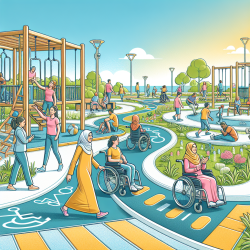Enhancing Accessibility in Public Parks: A Path to Inclusion
Public parks serve as vital spaces for physical activity, social interaction, and mental rejuvenation. However, for wheelchair users, these spaces can often present significant challenges due to accessibility barriers. A recent study titled "Assessment of park paths and trails to promote physical accessibility among wheelchair users in Saudi Arabia" sheds light on the current state of accessibility in five public parks in Riyadh, Saudi Arabia. This research not only highlights the existing challenges but also offers insights into how we can improve these spaces to promote inclusivity.
Key Findings from the Research
The study utilized the Path Environment Audit Tool (PEAT) to assess the accessibility of park paths and trails. The findings revealed both strengths and areas for improvement:
- Lateral Clearance: Most parks had adequate lateral clearance next to gates, facilitating easier access for wheelchair users.
- Path Surface Conditions: The condition of path surfaces varied significantly, with some parks having less accessible materials like bricks and stones.
- Accessibility of Restrooms: Accessible restrooms were inconsistent across parks, highlighting a need for improvement.
- Access Points: Many parks lacked consistent accessible access points, hindering the usability of park paths for wheelchair users.
The Role of Occupational Therapists
Occupational therapists (OTs) are uniquely positioned to advocate for and implement changes that enhance accessibility in public spaces. Their expertise in client-centered practice, environmental modification, and health promotion can drive significant improvements in park accessibility. Here are some actionable steps for OTs:
- Advocacy: Engage in public discourse to promote policy changes that prioritize accessibility in urban planning.
- Collaboration: Work with urban planners, architects, and local authorities to design inclusive parks that meet the needs of all users.
- Education: Conduct disability awareness programs for stakeholders to foster an inclusive mindset.
Future Directions
The study underscores the need for ongoing research and collaboration to enhance park accessibility. Future studies should include audits of additional parks and incorporate the perspectives of wheelchair users to ensure comprehensive assessments. By leveraging the Ecology of Human Performance Model, OTs can further inform initiatives related to outdoor settings.
For practitioners looking to improve their skills, this research serves as a call to action to engage in further studies and collaborations that promote inclusivity. By doing so, we can create public spaces that are welcoming and accessible to everyone, regardless of their mobility needs.
To read the original research paper, please follow this link: Assessment of park paths and trails to promote physical accessibility among wheelchair users in Saudi Arabia.










